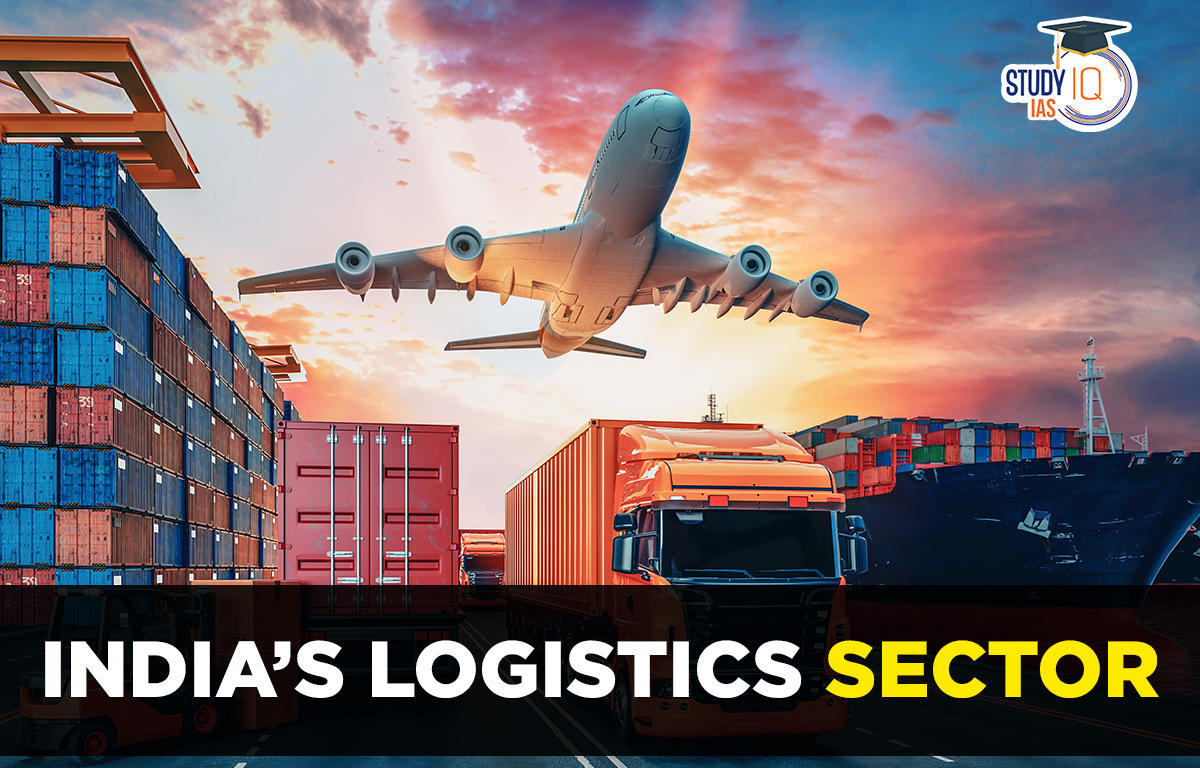Table of Contents
Context: India has improved its ranking on the World Bank’s Logistic Performance Index 2023 by six spots, now ranking at 38th out of 139 countries.
What is Logistics?
- Logistics is an element of the overall supply chain, but specifically refers to the set of processes involved in moving raw materials and finished goods from one point to another.
- It includes transportation and warehousing processes like: receiving, inventory management, demand planning, picking, packing and shipping, transportation management, and order fulfilment.
- Forward logistics refers to the movement of the goods from the manufacturer to customers, whereas Reverse logistics refer to moving products and materials back into the supply chain post-delivery.
About the World Bank’s Logistic Performance Index (LPI) 2023
- LPI is an interactive benchmarking tool for countries to identify challenges and opportunities in their trade logistics performance.
- It comes out every two years (from 2010 to 2018); however, after the COVID-19 break, the report has been released now in 2023.
- It measures the ease of establishing reliable supply chain connections and structural factors that make it possible, such as the quality of logistics services, trade and transport-related infrastructure, as well as border controls.
- The LPI 2023 allows for comparisons across 139 countries. The 2023 LPI for the first time measures the speed of trade with indicators derived from big datasets tracking shipments.
Major Highlights of the Logistic Performance Index (LPI) 2023
- Top performers: Singapore and Finland.
- India’s performance: India has significantly improved its performance on the LPI, having climbed up the ranking from 44th in 2018 to 38th in the 2023 listing.
- Furthermore, India’s ranking has improved drastically since 2014, when it was placed in the 54th position on the LPI.
- Reasons behind the improvement in India’s performance:
- Investments in Soft Infrastructure: PM Gati Shakti Scheme; National Logistics Policy; Cargo Tracking, use of RFID.
- Investment in hard infrastructure: e.g., trade-related infrastructure; reduction of delays in cargo tracking and dwell times, etc.,
- Investment in Technology: Digitalization; implementation of supply chain visibility platforms.
Significance of Logistics Sector in India
- Economic contribution: According to the Logistics Skill Council, the Indian logistics sector is valued at $150 billion, contributing 14.4% of the country’s GDP.
- Employment generation: The Indian logistics industry provides employment to more than 22 million people.
- High growth potential: According to ICRA, the sector has grown at a CAGR of 7.8% during the last five years and is expected to grow at 10.5% until 2025.
- Export promotion: Improving the logistics sector in India would facilitate a 10% decrease in indirect logistics cost leading to a growth of 5-8% in exports.
- Multiplier effect: Leading industries such as automotive components, pharmaceuticals, cement, textiles, FMCG and e-commerce depend hugely on warehousing and logistics.
- Supply chain resiliency: A good logistics ecosystem leads to effective movement of goods and optimizes the efficiency of supply chains.
- To minimize agricultural wastage: India loses almost 16% of its agricultural output due to improper logistics and supply chain limitations.
Challenges of Logistics Sector in India
| Infrastructural |
|
| Administrative |
|
| Structural |
|
Government Initiatives for India’s logistics Sector
- National Logistics Policy 2022: Government has unveiled National Logistics Policy (NLP) with the aim of promoting the seamless movement of goods and enhancing the competitiveness of the industry.
- Three targets under NLP 2022:
- First, to reduce cost of logistics in India to be comparable to global benchmarks by 2030.
- Second, improve the Logistics Performance Index ranking, to be among top 25 countries by 2030.
- Third, create data driven decision support mechanism for an efficient logistics ecosystem.
- Key features of NLP 2022:
- Multi-modal integration: NLP will facilitate a modal shift in logistics from the current over dependence on roads to railways and waterways by attempting a synergy between flagship projects such as Sagarmala, Bharatmala and PM GatiShakti National Master Plan.
- Use of technology and digitization: Such as Integration of Digital System (IDS) to 30 different systems of seven different departments related to logistics sector, and Unified Logistics Interface Platform (ULIP) to ensure continuous monitoring of cargo movement.
- Ease of doing business: Creation of Ease of Logistics (ELOG) Dashboard to simplify procedures and achieve ease of doing business and establishment of an empowered group of secretaries (EGoS) to monitor and review the implementation of the NLP.
- Three targets under NLP 2022:
- Multi Modal Logistics Park (MMLP):
- Freight aggregation and distribution hubs to bring down overall freight transportation costs.
- Road, air, railways, and waterways connectivity to facilitate smooth transition of freight across transportation modes and reduce lead times.
- Services like customs clearance and warehouse management systems to reduce inventory holding costs.
- Modern mechanized warehousing space.
- PM GatiShakti National Master Plan:
- It aims to create roads linked to railway lines that will further feed into major and minor ports, leading to the efficient movement of goods, especially from the frontiers.
- It will provide real-time visibility to fill the gap in the movement of goods, reduce costs and enhance the ease of doing business.
- Industrial corridors: To promote manufacturing clusters by connecting them to ports and consumption hubs via roads, railways and inland waterways.
- Sagarmala Project: Doubling the share of seaways in the transport mix over the next decade.
- National Logistics Efficiency and Advancement Predictability and Safety Act (NLEAPS):
- To modernize and formalize the logistics services and promote digitization in the sector.
- To reduce the logistics cost from the present 14% of GDP to less than 10% of GDP.
- Logistics division in the Department of Commerce: To improve existing procedures, identify the bottlenecks and introduce technology-based interventions.
- Logistics Data Bank (LDB) Project: Tracks movement of containers through rail or road till the container depot and using RFID tags.
- 100% FDI through automatic route: in the storage and warehousing sector.


 Editorial of the day (18th Apr): Great I...
Editorial of the day (18th Apr): Great I...
 Expansion of Universe, Speed, Reasons, I...
Expansion of Universe, Speed, Reasons, I...
 Current Affairs 18th April 2024 for UPSC...
Current Affairs 18th April 2024 for UPSC...

















